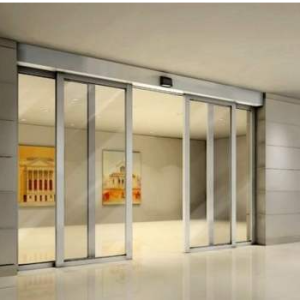The best sensor for automatic doors is the motion sensor, particularly the combination of Passive Infrared (PIR) and Microwave sensors. PIR detects body heat, while Microwave senses movement. This combination ensures reliable detection, reduces false activations, and provides optimal responsiveness for smooth and efficient door operation.

Introduction
Automatic doors have become a fundamental feature of modern establishments, offering convenience, security, and energy efficiency. You’ll commonly find them in shopping centers, hospitals, and office buildings. These doors use various sensor technologies to detect people or objects, triggering the doors to open or close accordingly.
Definition of an Automatic Door
An automatic door is a type of door that opens or closes automatically, typically powered by electricity. It can be triggered by a sensor or a switch. According to the American Association of Automatic Door Manufacturers, automatic doors should meet specific safety standards to ensure they don’t present a risk to users.
Importance of Sensors in Automatic Door Systems
Sensors play a critical role in the functionality of automatic doors. They detect the presence of an object or person within a specific range and send a signal to the door controller, prompting it to open or close. Some sensors, such as motion detectors or infrared sensors, work by identifying changes in the environment, like movement or heat. Others, like capacitive or optical sensors, detect changes in light or the electrical field.
Here’s a summary table indicating the average cost range of different types of sensors:
| Sensor Type | Average Cost Range (USD) |
|---|---|
| Motion Sensor | $50 – $100 |
| Infrared Sensor | $100 – $150 |
| Capacitive Sensor | $150 – $200 |
| Optical Sensor | $100 – $200 |
Types of Sensors for Automatic Doors
Motion Sensors (Passive Infrared, Microwave, Ultrasonic)
Motion sensors, including passive infrared (PIR), microwave, and ultrasonic, detect movement in their field of vision, triggering the automatic door to open or close.
- Passive Infrared (PIR) sensors detect changes in infrared radiation, typically emitted by humans and animals. The cost for PIR sensors ranges from $15 to $60.
- Microwave sensors emit microwave pulses and measure the reflection off a moving object. They are more expensive than PIR sensors, ranging from $50 to $100.
- Ultrasonic sensors emit ultrasonic waves and measure the reflection off a moving object. The price for these sensors is about $20 to $70.
Touch Sensors (Pressure, Capacitive)
Touch sensors, including pressure and capacitive, trigger the door to open or close when touched or when a certain amount of pressure is applied.
- Pressure sensors activate when weight is applied. These sensors can range from $50 to $100.
- Capacitive sensors detect a change in the electrical field and are slightly more expensive, typically ranging from $150 to $200.
Optical Sensors (Photoelectric, Laser)
Optical sensors, including photoelectric and laser sensors, work by detecting changes in light or by breaking a laser beam.
- Photoelectric sensors work by transmitting a light beam and activating when the beam is interrupted. The cost of these sensors can range from $100 to $200.
- Laser sensors work similarly but use a laser beam. They are usually the most expensive, ranging from $200 to $400.
| Sensor Type | Average Cost Range (USD) |
|---|---|
| Passive Infrared Sensor (PIR) | $15 – $60 |
| Microwave Sensor | $50 – $100 |
| Ultrasonic Sensor | $20 – $70 |
| Pressure Sensor | $50 – $100 |
| Capacitive Sensor | $150 – $200 |
| Photoelectric Sensor | $100 – $200 |
| Laser Sensor | $200 – $400 |
Comparison of Sensor Technologies
Different types of sensors come with varying capabilities and characteristics that make them more or less suitable for certain environments or applications. Key comparison criteria include detection range and coverage, response time and speed, and environmental adaptability.
Detection Range and Coverage
The detection range and coverage of a sensor refer to the distance within which the sensor can detect the presence of an object or person, and the area that it can cover.
- Microwave and ultrasonic sensors generally have a broader detection range, up to 30 feet, making them suitable for larger spaces.
- PIR sensors have a shorter range, usually around 15 feet, but their coverage is often adjustable, allowing them to fit smaller spaces.
- Laser and photoelectric sensors have focused detection ranges, typically up to 6 feet, making them suitable for applications requiring precision.
- Touch sensors, like capacitive and pressure sensors, have no detection range as they require physical contact to activate.
Response Time and Speed
The response time of a sensor is the time it takes for the sensor to detect an object or person and send a signal to the door controller. Speed is particularly important in high-traffic areas to ensure seamless access and avoid congestion.
- Microwave and ultrasonic sensors generally have the fastest response times, often within milliseconds, providing almost instant door activation.
- PIR and optical sensors have slightly slower response times but are still typically under a second.
- Touch sensors’ response times depend on the pressure applied but are generally relatively quick.
Environmental Adaptability
Environmental adaptability refers to the ability of a sensor to function correctly in various environmental conditions, such as temperature fluctuations, humidity, or light levels.
- Microwave and ultrasonic sensors can be affected by temperature changes and are best suited for indoor use.
- PIR sensors perform well in various lighting conditions but can be affected by temperature changes.
- Laser and photoelectric sensors can function in both indoor and outdoor conditions but may be affected by dust or direct sunlight.
- Touch sensors like capacitive and pressure sensors are adaptable to a wide range of environments.
Below is a comparison table of the different sensor technologies:
| Sensor Type | Detection Range | Response Time | Environmental Adaptability |
|---|---|---|---|
| Microwave Sensor | Up to 30 feet | Milliseconds | Best for indoor use |
| Ultrasonic Sensor | Up to 30 feet | Milliseconds | Best for indoor use |
| PIR Sensor | Up to 15 feet | Under a second | Adaptable, but can be affected by temperature |
| Laser Sensor | Up to 6 feet | Under a second | Adaptable, but can be affected by dust or direct sunlight |
| Photoelectric Sensor | Up to 6 feet | Under a second | Adaptable, but can be affected by dust or direct sunlight |
| Capacitive Sensor | N/A (Requires touch) | Varies (Quick) | Highly adaptable |
| Pressure Sensor | N/A (Requires touch) | Varies (Quick) | Highly adaptable |
Testing and Maintenance
Regular testing and maintenance of automatic door sensors are essential to ensure they function correctly and safely. This usually involves checking the sensor’s functionality, range, and response time. A professional should perform maintenance at least once a year, but high-traffic locations might require more frequent checks.
- Typical maintenance costs for sensors range from $50 to $200 annually, depending on the type of sensor and frequency of use.
https://www.youtube.com/watch?v=c4-8Y7jUCn0
Integration with Access Control Systems
Automatic door sensors often integrate with access control systems to manage who can access a building and when. This can enhance security and allow for efficient traffic flow.
- Integration costs depend on the complexity of the access control system, but usually range from $1,000 to $3,000.
RFID and Biometric Integration
Some automatic door systems can integrate with Radio Frequency Identification (RFID) or biometric systems for even greater security. These systems can authenticate identities based on unique characteristics such as fingerprints, iris patterns, or RFID tags.
- RFID systems typically cost between $500 and $2,000, while biometric systems can range from $1,000 to $3,000, depending on the sophistication of the technology.
Integration with Building Automation Systems
Automatic door sensors can integrate with Building Automation Systems (BAS) to control various building functions such as heating, ventilation, and air conditioning (HVAC), lighting, and security. By synchronizing with the BAS, automatic doors can enhance energy efficiency and user comfort.
- The cost of integrating an automatic door system with a BAS typically ranges from $2,000 to $5,000, depending on the complexity of the systems involved.
| Activity | Typical Cost Range |
|---|---|
| Sensor Testing & Maintenance | $50 – $200 per year |
| Integration with Access Control Systems | $1,000 – $3,000 |
| RFID Integration | $500 – $2,000 |
| Biometric Integration | $1,000 – $3,000 |
| Integration with Building Automation Systems | $2,000 – $5,000 |

